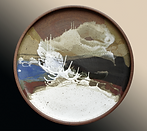
Studio S
P O T T E R Y
WELCOME!
Scroll Down For Additional Information
Crafting a Living
by Sara Askew Jones
Southern Living Volume 36, Number 11, November 2001
Walking through the converted dairy barn, artist Lewis Snyder stops at one of the potter's wheels and sits down for a moment. He leans over and demonstrates how he expertly uses the tool to form a vessel. Then, in a quiet voice, Lewis begins to share his thoughts on the artwork that shapes his life.
"Whether it's throwing the clay, glazing the pots, or firing the kiln, there's a drive that satisfies me," he explains. "I take an idea, let it grow, and then work it in a constant pursuit that results in my style--a purpose."
Lewis's gentle manner initially fails to convey the overwhelming passion he feels for crafting pottery. That zeal becomes obvious after spending time with Lewis in the studio and realizing the sheer volume of work he and his son produce.
A Creative Space
Lewis opened Studio S Pottery in 1970 as a respite from the demands of his position at Middle Tennessee State University (MTSU). There he taught classes and created the program for three-dimensional art.
"[The studio] started out just as a place for myself," Lewis explains, "but it never really ended up that way. I've always share it with others--giving students the opportunity to work in a sort of interim facility before they went out on their own."
In 1972 he took a leave of absence from MTSU to develop the crafts program for the Tennessee Arts Commission. The artist eventually decided to devote all his energies to the art form that captured his attention as a college student. He left behind politics and created a life out of clay.
A Family Art
At this moment, Lewis' son joins him in the wheel room Eric's shy demeanor, like his father's, belies the passionate personality that emerges when he talks about the studio and pottery.
"Growing up [around pottery], I just absorbed it," Eric explains. "The studio has always been a part of my life and my dad was always here working."
A circuitous route brought Eric back to the family business. After graduating from college with a degree in communications, Eric took a part-time job at a Nashville radio station. "Since it didn't pay very well, I had to supplement my income," Eric says. "The most attractive thing was to come out here to the studio and make this the other half of [making a living]. Sooner or later, one had to dominate the other." Eric joined his dad full time in 1990.
Though the duo works as a team, each Snyder claims a specialty. 'We sort of divide the work here," Lewis explains. 'Eric does the hand-building part of it, and I do the throwing. Then of course, we work on a lot of things together."
Repeating History
In the mid-seventies, the studio began doing architectural terra-cotta work for restoration projects. A local contractor, who was restoring the hermitage Hotel in Nashville, asked the Snyders to duplicate some pieces needed for the job.
"We tried it and were successful," Lewis says. "The next thing we knew, we were doing several jobs and were listed on the federal government's national registry for restoration work."
Since that time, the father-and-son team has completed works for numerous buildings around the country. Often these restorations require the creation of 300 to 400 terra-cotta pieces per project. Studio S Pottery remains one of only a few companies able to provide this type of specialty work. Even though the effort pays well, Lewis and Eric consider each job carefully before they commit.
"It's easy to get into more production and lose your individuality of work," Lewis explains. "Even though we use interns to help with some jobs, that's about as commercial as we have gotten."
Studio Hours
Lewis and Eric work at a staggering pace. They spend long hours in the studio creating and completing new pieces, developing glazes, and working on commissions. In addition, both teach community pottery classes several nights a week.
"I guess the pace was set when I was in graduate school," Lewis says. "At the time, it was so competitive because there were so many students who had been in the Korean War. There was this urgency and purpose to begin our lives and start a career. I never got over that."
The Snyder's' attention to quality craftsmanship and creative styles pays off. Many museums showcase their work, including the Renwick Gallery at The Smithsonian Institution in Washington, D.C., and the Museum of Contemporary Crafts in New York. In addition, Lewis and Eric have produced dinnerware, ornaments, and commemorative plates for every Presidential administration since Richard Nixon.
Regardless of the long hours and pressures of running their own business, neither Eric nor Lewis wants to cut back on creating and crafting a life out of clay.
"As long as there is a challenge, I'll be working at this," Lewis says. "And with clay, there will always be something to do and something new to learn."

Lewis & Eric Snyder